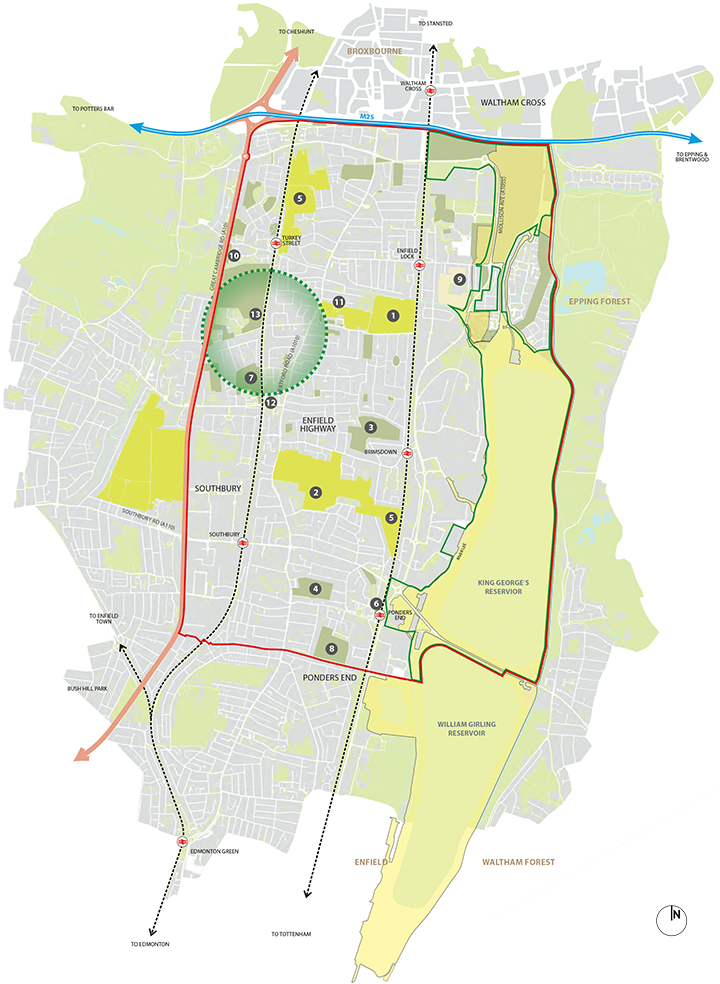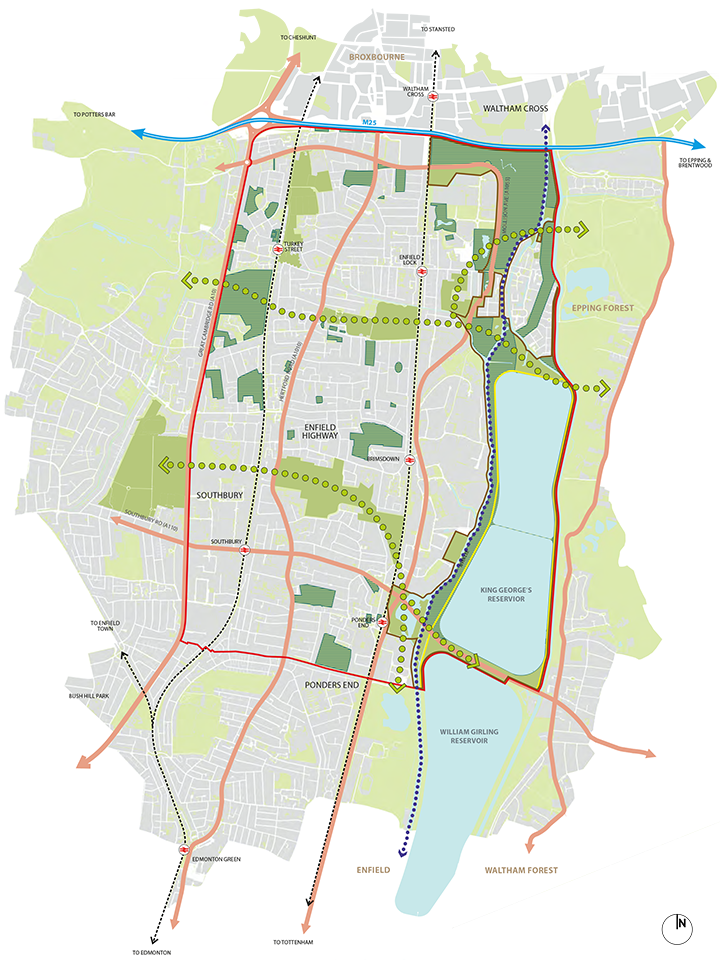
North East Enfield has some excellent open spaces, not least the Lee Valley Regional Park and Waterways. But it also has some shortfalls. This section sets out policies to improve green spaces in the area, provide new elements to connect the green network together and support local food growing.
8.1.1 The overall policy approach is to ensure that there is a network of well connected open spaces within North East Enfield, providing a mix of different spaces and facilities for all age groups. The Lee Valley Regional Park and Waterways, an important natural asset to the area will serve local and regional needs. Smaller local and pocket parks and children’s play areas, integrated into residential areas and neighbourhood centres, will serve local needs. This will be achieved by:
8.2.1 On the whole, the NEE area has good access to a wide range of different types of open space. However, the Council’s Open Spaces and Sports Assessment update [2012] identified a number of deficiencies and these are:
8.2.2 Public Parks: The NEE area is below the quantity standard for park provision, the quality of parks is mixed and there some accessibility issues. The study shows that the major deficiencies in the NEE area are:
8.2.3 The study recommends that providing new parks and upgrading existing spaces should be a priority, and sets out that there is an opportunity to upgrade the status of St Georges Playing Field, which is currently categorised as a public playing field but could be upgraded to a Small Local Park by introducing additional facilities such as seating and children’s play. The site is large enough to accommodate such facilities without removing pitches required to meet demand in the Borough.
 Pocket park on the A1010 Hertford Road |
 Albany Park |
 Hertford Road Cemetery links to Durants Park |
Policy Context for Chapter 8: Green Network and Food Growin |
|
London Plan |
Policy 2.18: Green Infrastructure Policy 7.16: Green Belt Policy 7.17: Metropolitan Open Land Policy 7.18: Protecting local open space and addressing local deficiency Policy 7.19: Biodiversity and Access to Nature Policy 7.22: Land for Food |
Upper Lee Valley Opportunity Area Planning Framework (July 2013) |
Objective 8 8.3: Opening up the Lee Valley Regional Park 8.4: Ponders End Indicative Masterplan |
Core Strategy (Adopted Nov 2010) |
Policy 11: Recreation, leisure, culture and arts Policy 12: Visitors and tourism Policy 33: Green belt and countryside Policy 34: Parks, playing fields and other open spaces Policy 35: Lee Valley Regional Park and Waterways Policy 36: Biodiversity |
Proposed Submission Development Management Document (March 2013) |
Policy DMD72: Protection and enhancement of open space Policy DMD72: Open Space Provision Policy DMD73: Children’s Play Space Policy DMD74: Playing Pitches Policy DMD75: Waterways Policy DMD76: Wildlife Corridors Policy DMD77: Green Chains Policy DMD78: Nature Conservation Policy DMD79: Ecological Enhancements Policy DMD82: Protecting the Greenbelt Policy DMD85: Land for Food and Other Agricultural Uses |
Other Sources |
National Planning Policy Guidance Enfield Open Space and Sports Assessment Update (Atkins), 2011 Lee Valley Regional Park Development Framework - Area 5 Proposals Metropolitan Open Land and Green Chain Associated Open Space Review, 2013 Green Belt Review, 2013 Ponders End Waterfront Big Green Fund Bid, 2013 Enfield Food Strategy and Action Plan, 2011 |
8.2.4 Playing pitches: Playing pitches in secure community use are limited in the North East Enfield area at present and there are some accessibility issues. Therefore provision of new outdoor sports pitches should be a high priority particularly given the higher proportion of the population not in good health in this area. The study also recommends that improvements are made to the following pitches:
8.2.5 Allotments: Allotment provision in the North East Enfield area is slightly below the quantity standard, there are also some accessibility issues although large parts of the North East Enfield area are within an allotment catchment meaning that allotments should be considered a priority but not the top priority for new developments.
8.2.6 The study recommends that an allotment site or sites are found in the area south of Turkey Brook and north of Carterhatch Lane, between A10 and A1010. The study also recommends that the Council develops a Borough-wide vision for allotments, integrated with other strategies. The Council’s emerging Food Strategy incorporates this vision.
8.2.7 Natural green space: There are currently sufficient natural green spaces in the North East Enfield area, with only a small area adjacent to the M25 being deficient. However, much of the central part of the NEE area is some 2000m walking distance from natural and semi-natural greenspace – that is, a walking time of around 30 minutes. The main areas of natural and semi-natural greenspace in the NEE area are:
8.2.8 On balance provision of natural greenspace is not considered a priority for provision in new developments. However, there are opportunities to improve pedestrian and cycle connections to the natural greenspace of the Lee Valley Regional Park, and this would fit with other policy aspirations to improve movement in general throughout the NEE area. However, it is important that recreational needs are balanced with ecological sensitivities and so recreation should be encouraged in the areas that are least sensitive. The Council already works closely with the Lee Valley Regional Park Authority, and will continue to work within the parameters of the Lee Valley Park Development Framework in promoting sustainable use of the Park resource whilst protecting its biodiversity value, particularly those area with international and national designations to avoid any adverse impacts on the integrity of the Lee Valley Special Protection Area / Ramsar site.
 The attractive pocket park on Teal Close |
 Turkey Brook |
8.2.9 Areas with Ecological Designations: There is broad area either side of the A1010 Hertford Road that is deficient in access to areas with ecological designations - that is, outside of the recommended 1km distance. The study recommends improving nature conservation within Durants Park and Albany Park to address this deficiency. The future development of the Ponders End Waterfront area also has the potential to bring greenspace with nature conservation value within reach of local people.
8.2.10 Children’s Play Provision: At present the level of children’s play provision is below the recommended standard of 0.48 sqm per child, there are accessibility issues and the area has a high proportion of children aged 0-15. Also users of children’s play areas in North East Enfield area tend to use them more frequently than other parts of the Borough. Given these issues the provision of children’s play facilities is considered one of the key priorities for new provision in the area. The main areas that are deficient in children’s play provision are:
8.2.11 The study recommends that shortfalls are addressed in part by upgrading existing play areas that do not currently count towards provision so that they meet the standards required for Local Equipped Areas for Play (LEAPs) or Neighbourhood Equipped Areas for Play (NEAPs). The following play areas are identified as being suitable for upgrade:
8.2.12 There are several open spaces within deficiency areas which do not currently accommodate provision for children’s play but have the potential to accommodate such facilities. The introduction of LEAP or NEAP standard play equipment to these spaces would alleviate some of the current deficiencies in access to children’s play. Within the AAP area these are:
 Lee Valley Regional Park & Waterways |
 Ponders End Waterfront |
8.2.13 In summary, the priorities for new open space provision in the NEE area are:
8.2.14 Some additional allotment provision will also be important but is a lower priority. There is limited need for more natural greenspace.
Policy 8.1: Enhancing existing open spaces The Council will seek to implement the recommendations in Open Spaces and Sports Assessment update [2012]. These are:
|

Durants Park
Policy 8.2: Providing new open space The Council will explore the potential for new playing pitches within existing open spaces. The Council will require developers to provide new playing pitches within new development of sufficient scale to accommodate them in accordance with Core Strategy Policy 34 and DMD Policy 74 Where new development of sufficient scale comes forward, the Council will require developers to provide new public parks as an integral part of the scheme in accordance with Core Strategy Policy 34. Where new development regenerates existing areas, replacement of or improvements to existing open space will be required. As part of the Alma Estate Regeneration, new open spaces will be required to replace the existing spaces. The Council will require on-site provision of children’s play space in new development in accordance with Core Strategy Policy 34 and DMD Policy 73. |
Figure 8.1: Open Space Enhancements


8.3.1 As existing open spaces with the NEE area are improved and new open spaces are provided during the lifetime of this AAP, there is an opportunity to connect them together to create a network of green space. Connecting spaces together will help to:
8.3.2 Figure 8.2 identifies the strategic green corridors that are key in connecting spaces together. There are other corridors and spaces that could also connect the area’s main spaces together, but these are the most important links
Policy 8.3: Joining green spaces together The Council will develop a strategy to create a series of eastwest strategic green corridors connecting existing spaces spaces and the River Lee Navigation together as set out in Figure 8.2. These corridors will be designed to reflect the character of the neighbourhoods through which they pass and will therefore change character along their length. Schemes should include new native planting and, where appropriate, water features, ecological habitats, softening hard edges and so on. Where new development forms part of or is immediately adjacent to a strategic green corridor, the Council will require the development to incorporate appropriate landscape elements to support the overall corridor. |
8.4.1 The Council is developing a Food Strategy for Enfield. There are three key drivers for the development of the Food Strategy:
8.4.2 Coupled with this, there is mounting interest in the production and consumption of healthier, more sustainable food in Enfield. Individuals and community groups are increasingly growing food in back gardens, on allotments and other sites across the Borough. More and more schools are setting up their own growing spaces while using healthy food to learn about healthier lifestyles. Community participation in food production presents the opportunity to reduce spatial inequalities. Demand for fairly-traded, local products and nutritional labelling on food is increasing, empowering consumers and supporting local businesses.
8.4.3 There is a long history of agriculture and horticulture in the Borough, which has played an important role in how Enfield has developed. The food sector continues to be an important contributor to Enfield’s economy, with a range of small-scale producers, wholesalers and large companies generating significant income and providing many jobs. There is potential to re-introduce market gardening to the NEE area to help support the Food Strategy.
Policy 8.4: Encouraging local food growing As part of the Borough-wide Food Strategy, the Council will develop a strategic approach to food growing sites, including:
|
Figure 8.2: Strategic Green Corridors


< Previous | ^ Top | Next >